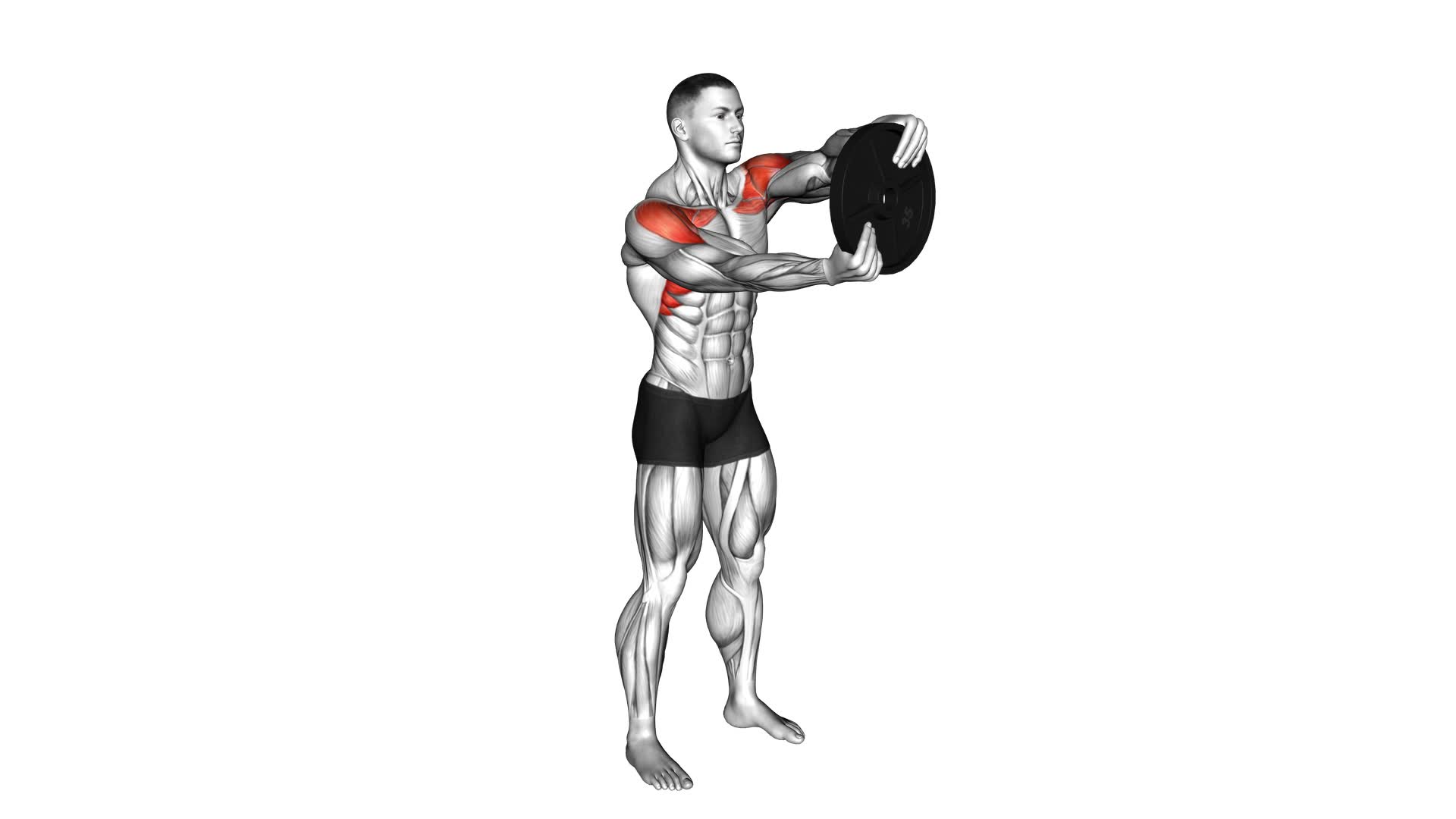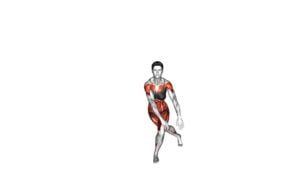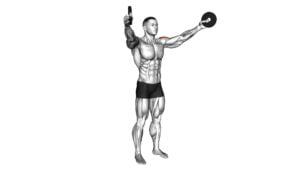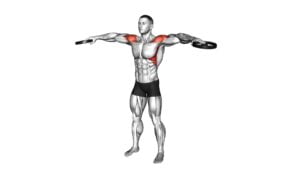Weighted Round Arm – Video Exercise Guide & Tips

Are you looking to tone your arms and build strength? Look no further than the Weighted Round Arm exercise!
Watch This Exercise Video
This video exercise guide will show you the proper technique and give you tips to get the most out of this exercise.
Avoid common mistakes and discover variations and progressions to challenge yourself.
With safety precautions in mind, you'll be on your way to achieving your fitness goals in no time.
Let's get started!
Key Takeaways
- The weighted round arm exercise improves upper body strength and muscular endurance.
- It targets the shoulders, chest, and arms.
- It increases resistance and muscle activation.
- It enhances overall muscle mass and metabolism.
Benefits of the Weighted Round Arm Exercise
The weighted round arm exercise offers numerous benefits for improving upper body strength and muscular endurance. Strength training is crucial for overall fitness and health, and this exercise specifically targets the upper body muscles, including the shoulders, chest, and arms. By incorporating weights into the movement, you increase the resistance and challenge your muscles to work harder. This leads to greater muscle activation during the exercise, resulting in increased strength and muscle development.
One of the main benefits of strength training is that it helps to increase your overall muscle mass. This not only improves your physical appearance but also enhances your metabolism, making it easier to maintain a healthy weight. Additionally, the weighted round arm exercise helps to improve your posture and stability by strengthening the muscles that support your spine and shoulders.
Muscle activation during exercise is an important aspect of strength training. When you perform the weighted round arm exercise, you engage multiple muscle groups simultaneously. This not only improves your muscular endurance but also helps to prevent muscle imbalances and reduce the risk of injury.
Proper Technique for the Weighted Round Arm Exercise
To perform the weighted round arm exercise correctly, you'll need a set of dumbbells. Here are the steps to ensure proper technique:
- Stand with your feet shoulder-width apart and hold a dumbbell in each hand.
- Bend your knees slightly and maintain a straight back throughout the exercise.
- Start with your arms extended in front of you, parallel to the ground.
- Keeping your elbows slightly bent, slowly rotate your arms outward in a circular motion, as if you were drawing a large circle in front of you.
By following these steps, you can maximize the benefits of the weighted round arm exercise. This exercise targets your shoulder and upper back muscles, helping to improve strength and stability in those areas. It also helps to improve your posture and enhance your overall upper body strength.
To add variation to this exercise, you can try using different weights or using a resistance band instead of dumbbells. You can also change the speed and direction of the circular motion to challenge your muscles in different ways.
Now that you know the proper technique for the weighted round arm exercise, let's discuss some common mistakes to avoid during this exercise.
Common Mistakes to Avoid During the Weighted Round Arm Exercise
Avoid these mistakes when performing the weighted round arm exercise to ensure proper technique and prevent injuries.
- Using too much weight: Choose a weight that allows you to maintain control and proper form throughout the exercise. Using excessive weight can lead to compromised form, increasing the risk of muscle strains or other injuries.
- Using improper form: Keep your core engaged and your back straight throughout the exercise. Avoid arching your back or allowing it to round. Also, make sure to fully extend your arms in front of you without locking your elbows. This will help to engage the targeted muscles and prevent unnecessary strain on your joints.
- Rushing through the exercise: Take your time and focus on the movement, ensuring that you're performing it correctly. Rushing can lead to sloppy form, increasing the risk of injury.
- Neglecting the warm-up: Performing the weighted round arm exercise without a proper warm-up can increase the risk of muscle strains or other injuries. Take a few minutes to warm up your muscles with some light cardio or dynamic stretches before starting the exercise.
Variations and Progressions for the Weighted Round Arm Exercise
Ready to take your weighted round arm exercise to the next level? Here are some variations and progressions to help you challenge yourself and continue making progress:
- Increase the weight: Start by gradually increasing the weight of the dumbbell or kettlebell you're using. This will add resistance and make the exercise more challenging for your muscles.
- Change the grip: Instead of holding the weight with a neutral grip, try using an overhand or underhand grip. This will engage different muscles in your arms and shoulders, providing a different stimulus to your workout.
- Add a twist: As you lift the weight, incorporate a twist in your torso. This will engage your obliques and core muscles, making the exercise more dynamic and engaging more muscle groups.
- Combine with other exercises: Incorporate the weighted round arm exercise into a circuit or superset with other upper body exercises. This will keep your workout varied and help you target different areas of your arms and shoulders.
By incorporating these variations and progressions into your weighted round arm exercise routine, you can continue challenging your muscles and making progress towards your fitness goals.
Now, let's move on to some tips for getting the most out of the weighted round arm exercise.
Tips for Getting the Most Out of the Weighted Round Arm Exercise
To get the most out of the Weighted Round Arm exercise, it's important to focus on proper form techniques. Ensure that your back is straight, shoulders are relaxed, and core is engaged throughout the movement.
Additionally, choosing the correct weights is crucial for challenging your muscles without sacrificing form. Avoid using weights that are too heavy, as this can lead to improper technique and potential injuries.
Lastly, be mindful of common mistakes such as swinging the arms or arching the back, and make necessary adjustments to maintain proper form and maximize the effectiveness of the exercise.
Proper Form Techniques
To maximize the effectiveness of the Weighted Round Arm exercise, ensure that you maintain proper form throughout the movement. Here are some tips for executing the exercise with proper form:
- Stand with your feet shoulder-width apart and hold the weighted round arm in both hands, arms extended in front of you.
- Keep your back straight and engage your core muscles to maintain stability.
- Bend your elbows and bring the weighted round arm towards your chest, keeping your upper arms close to your body.
- Slowly extend your arms back to the starting position, fully straightening your elbows.
By following these proper form techniques, you'll target and engage the muscles in your arms, shoulders, and upper back effectively.
Now, let's move on to the next section about choosing the correct weights to use for this exercise.
Choosing Correct Weights
Choose the appropriate weight for the Weighted Round Arm exercise to optimize your results and avoid strain or injury. Proper form techniques and equipment selection are crucial in achieving the desired benefits from this exercise.
When selecting weights, consider your current fitness level and the specific goals you want to achieve. Start with lighter weights and gradually increase the load as you build strength and endurance.
It's important to maintain proper form throughout the exercise, so choose a weight that allows you to perform the movement with control and without compromising your technique. Remember, it's better to start with lighter weights and gradually progress, rather than using weights that are too heavy and risking injury.
Listen to your body and adjust the weight accordingly to ensure a safe and effective workout.
Avoiding Common Mistakes
As you progress with the Weighted Round Arm exercise, it's important to focus on avoiding common mistakes that may hinder your progress and limit the effectiveness of the exercise. Here are some tips to help you avoid injuries and improve your shoulder strength:
- Maintain proper form: Make sure to keep your back straight and engage your core muscles throughout the exercise. This will help prevent strain on your lower back and improve overall stability.
- Start with lighter weights: It's important to gradually increase the weight you use for the exercise. Starting with lighter weights will allow you to focus on proper technique and reduce the risk of injury.
- Avoid using momentum: The goal of the exercise is to strengthen your shoulder muscles, so avoid swinging or using momentum to lift the weights. Instead, focus on controlled movements and engage the targeted muscles.
- Listen to your body: If you experience any pain or discomfort while performing the exercise, stop immediately. Pushing through pain can lead to injuries, so it's important to listen to your body and adjust accordingly.
Safety Precautions for the Weighted Round Arm Exercise
To ensure your safety while performing the Weighted Round Arm exercise, it's important to focus on proper form techniques. This includes maintaining a stable core and keeping your shoulders relaxed throughout the movement.
Additionally, selecting the appropriate equipment and starting with a manageable weight will help prevent injuries.
Proper Form Techniques
How can you ensure proper form and safety when performing the weighted round arm exercise? Follow these tips to correct your form and activate the right muscles:
- Stand with your feet shoulder-width apart and your knees slightly bent. This will provide a stable base for the exercise.
- Hold the weighted round arm with both hands, keeping your elbows bent and close to your body. This will engage your biceps and shoulders.
- As you lift the weight, exhale and extend your arms in front of you. Maintain a slight bend in your elbows to avoid hyperextension.
- Slowly lower the weight back to the starting position, inhaling as you do so. Focus on controlling the movement and engaging your core for stability.
Equipment Selection Guidelines
Are there specific safety precautions you should consider when selecting equipment for the weighted round arm exercise? Absolutely. When it comes to equipment selection, there are a few important factors to keep in mind to ensure a safe and effective workout.
First and foremost, choose weights that are appropriate for your fitness level. Start with lighter weights if you're a beginner and gradually increase the weight as you become stronger.
Additionally, make sure the weights are securely fastened to your wrists or hands to prevent them from slipping or falling off during the exercise.
It's also crucial to use proper form and technique while performing the exercise to avoid any unnecessary strain or injury.
By following these equipment selection guidelines and taking the necessary safety precautions, you can enjoy a safe and successful weighted round arm workout.
Now, let's move on to some injury prevention tips.
Injury Prevention Tips
What safety precautions should you take to prevent injuries while performing the weighted round arm exercise? Here are four important tips to keep in mind:
- Warm up: Before starting the weighted round arm exercise, it's crucial to warm up your muscles and joints. This helps increase blood flow, flexibility, and reduces the risk of injury.
- Start with lighter weights: If you're new to the weighted round arm exercise, it's best to start with lighter weights. This allows your muscles to gradually adapt and prevents strain or overexertion.
- Maintain proper form: Proper form is essential to prevent injuries. Keep your back straight, engage your core, and lift the weights using controlled movements. Avoid any jerking or swinging motions.
- Listen to your body: Pay attention to any discomfort or pain during the exercise. If you feel any strain or excessive discomfort, stop immediately and seek guidance from a fitness professional.
Frequently Asked Questions
How Many Sets and Repetitions Should I Do for the Weighted Round Arm Exercise?
For the weighted round arm exercise, it's recommended to do 3 sets of 12 repetitions. This will help you build strength and endurance in your arms.
Make sure to start with a weight that challenges you but allows you to maintain proper form throughout the exercise. Focus on keeping your core engaged and your back straight as you lift the weights.
Remember to listen to your body and adjust the weight as needed.
Can I Use Dumbbells Instead of a Weighted Round Arm for This Exercise?
Yes, you can use dumbbells as an alternative to the weighted round arm exercise. While the weighted round arm has its own unique benefits, using dumbbells can still provide similar results.
Dumbbells allow for a wider range of motion and can help improve overall strength and muscle definition. Just make sure to choose dumbbells that are challenging enough for you and maintain proper form throughout the exercise.
What Muscles Does the Weighted Round Arm Exercise Target?
The weighted round arm exercise targets multiple muscles in your upper body, including the shoulders, biceps, and triceps.
By incorporating variations of the exercise, you can also engage your core and improve stability.
The benefits of the weighted round arm exercise include increased upper body strength, improved muscle definition, and enhanced shoulder stability.
It's a versatile exercise that can be adapted to suit your fitness level and goals.
Is the Weighted Round Arm Exercise Suitable for Beginners?
The weighted round arm exercise can be suitable for beginners. It offers numerous benefits such as improving upper body strength and increasing muscle endurance.
To modify the exercise for beginners, you can start with lighter weights or even use no weights at all. This allows you to focus on proper form and technique before gradually increasing the weight. Remember to listen to your body and start with a weight that feels comfortable for you.
Can I Perform the Weighted Round Arm Exercise if I Have a Shoulder Injury?
If you have a shoulder injury, it's important to be cautious when performing the weighted round arm exercise. It may not be suitable for you in its original form.
However, there are modified exercises for shoulder injuries that you can try instead. These exercises can help you strengthen your upper body without putting too much strain on your injured shoulder.
It's always best to consult with a healthcare professional or a qualified trainer for alternative exercises that suit your specific condition.
Conclusion
In conclusion, the weighted round arm exercise is a beneficial exercise that targets multiple muscle groups in the upper body. By using proper technique and avoiding common mistakes, you can maximize the effectiveness of this exercise.
Additionally, there are variations and progressions available to challenge yourself as you improve. Remember to follow safety precautions to prevent any injuries.
Incorporating the weighted round arm exercise into your fitness routine can help you build strength and improve your overall upper body fitness.

Author
Years ago, the spark of my life’s passion ignited in my mind the moment I stepped into the local gym for the first time. The inaugural bead of perspiration, the initial endeavor, the very first surge of endorphins, and a sense of pride that washed over me post-workout marked the beginning of my deep-seated interest in strength sports, fitness, and sports nutrition. This very curiosity blossomed rapidly into a profound fascination, propelling me to earn a Master’s degree in Physical Education from the Academy of Physical Education in Krakow, followed by a Sports Manager diploma from the Jagiellonian University. My journey of growth led me to gain more specialized qualifications, such as being a certified personal trainer with a focus on sports dietetics, a lifeguard, and an instructor for wellness and corrective gymnastics. Theoretical knowledge paired seamlessly with practical experience, reinforcing my belief that the transformation of individuals under my guidance was also a reflection of my personal growth. This belief holds true even today. Each day, I strive to push the boundaries and explore new realms. These realms gently elevate me to greater heights. The unique combination of passion for my field and the continuous quest for growth fuels my drive to break new ground.







